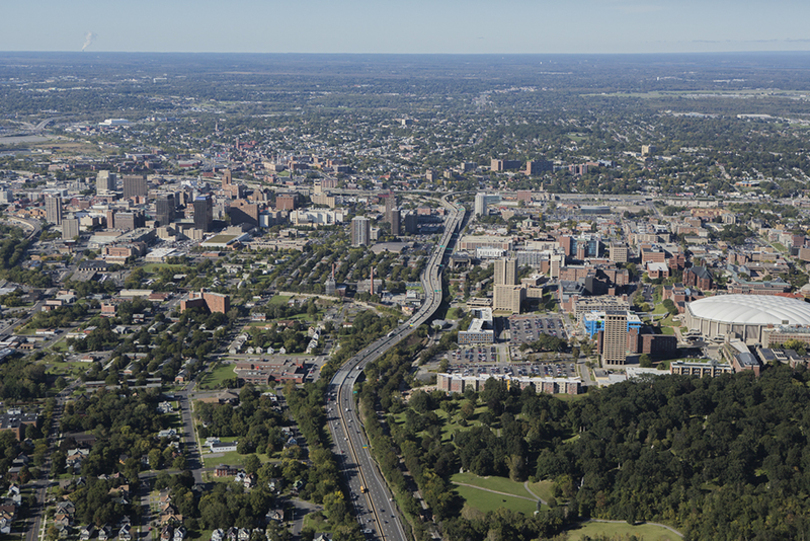County opioid overdose rate higher than national average, new tool shows

In 2017, 76 people in Onondaga County died from opioid overdoses, according to state data. Daily Orange File Photo
The fatalities from opioid overdose in Onondaga County exceeded state and national averages between 2012 and 2016, a new online tool shows, though data also indicates that the opioid overdose rate in 2018 so far has decreased since 2017.
At a rate of 22.6 people per 100,000, the mortality rate from opioid overdose in Onondaga County between 2012 and 2016 exceeds the mortality rate in New York state, which was 14.8, and the national rate, which was 22.5.
Opioids are pain-reducing medications that include prescription and illegal drugs, like oxycontin, hydrocodone and heroin.
Monika Taylor, director of behavioral health at Crouse Hospital said the hospital offers inpatient and outpatient drug treatment programs. The inpatient facility offers gender specific treatment for both men and women 18 years old and over, she said.
Taylor said Crouse’s outpatient program has about 760 patients from a variety of demographic backgrounds. The patients range from 18 to 70 years old, and the majority of patients are white, she said.

Laura Angle | Digital Design Editor
The outpatient rehabilitation program in Crouse Hospital has several levels of care. Some patients go in for therapy and vocational support four or five days a week. There was a list of more than 400 people who waited 14 to 16 months to get into treatment in previous years, she said.
In addition to Crouse, Ross Sullivan, director of the Opioid Bridge Clinic at SUNY Upstate Medical University, said the clinic has seen about 500 people in the past two and a half years. Seventy-five to 80 percent of those patients were linked to more treatment after their initial clinic treatment, he said.
Sullivan, who started the clinic, said many people who started in the emergency department after an overdose or withdrawal have come back to see him and are still sober two to three years later.
“To really be able to see somebody change their life and become healthy, whether it be a productive member of society or productive family member or friend, it’s really the most rewarding thing,” Sullivan said.
Taylor said prescription drug drop-off centers are stationed in different police departments throughout the community. The centers act as incentives to encourage people to discard unused medication, she said.
Mariah Senecal-Reilly, Onondaga County Health Department program director, said the department has been working with the Onondaga County Drug Task Force to increase access to treatment. Treatment can include naloxone, a medication that reverses an opioid overdose, or medical providers who are able to do medication-assisted treatment.
Senecal-Reilly said the health department provides and trains for the use of naloxone. In early December, it will begin providing the drug to community and government agencies.
“Our goal is to flood the community with naloxone so that every business has a kit,” she said. “If there’s an occurrence where there’s an overdose, there’s the possibility to reverse it.”

Laura Angle | Digital Design Editor
Between January and March, the number of opioid overdoses in Onondaga County was lower than during the same period in 2017, according to data from the New York State Department of Health.
Experts attributed the drop to expanded prevention efforts and increased awareness in the community. But they added that there isn’t a concrete trend yet, and more work remains to be done in treating and preventing addiction.
Data from 2017 shows that national drug overdose mortality increased dramatically from 2016 and 2015.
Senecal-Reilly said one year isn’t enough to call the data a trend, but in general, removing stigmas surrounding drug addiction can encourage people to seek treatment.
Michael Meit, co-director of the NORC Walsh Center for Rural Health Analysis, an independent research institution at the University of Chicago, led the development for the tool with a team of researchers. He said that there are areas that stand out across the country, like northern California, Oklahoma, southeastern Ohio, Pennsylvania and Maryland.
The National Opioid Misuse Community Assessment tool, developed by NORC in partnership with the U.S. Department of Agriculture, compares county-level overdoses to state and federal rates.
The country only recently learned just how addictive opioids are, and many addicts “fell into a trap,” Meit said. He said the spikes in overdose deaths are linked to fentanyl, a synthetic opioid that is stronger than heroin.
Meit added that the high cost of Narcan — a brand name of naloxone — is a barrier to combating opioid overdose. Narcan costs about $130 to $140 for a kit with one to two doses, but overdose reversal may require several doses, according to Time. Evzio, another naloxone brand, costs about $4,500 per kit, according to Wired.
Meitl said that fighting the opioid crisis would take a combination of local, state and federal resources, but it is best targeted on a local level.
Future research will include developing city-based versions of the tool that would better assess urban areas, as well as other measures to show where federal resources are being invested to address the opioid issue, Meit said.
New data will be released in December and will be incorporated in the tool, he said.
“I do not think we have seen the peak yet,” Meit said.





